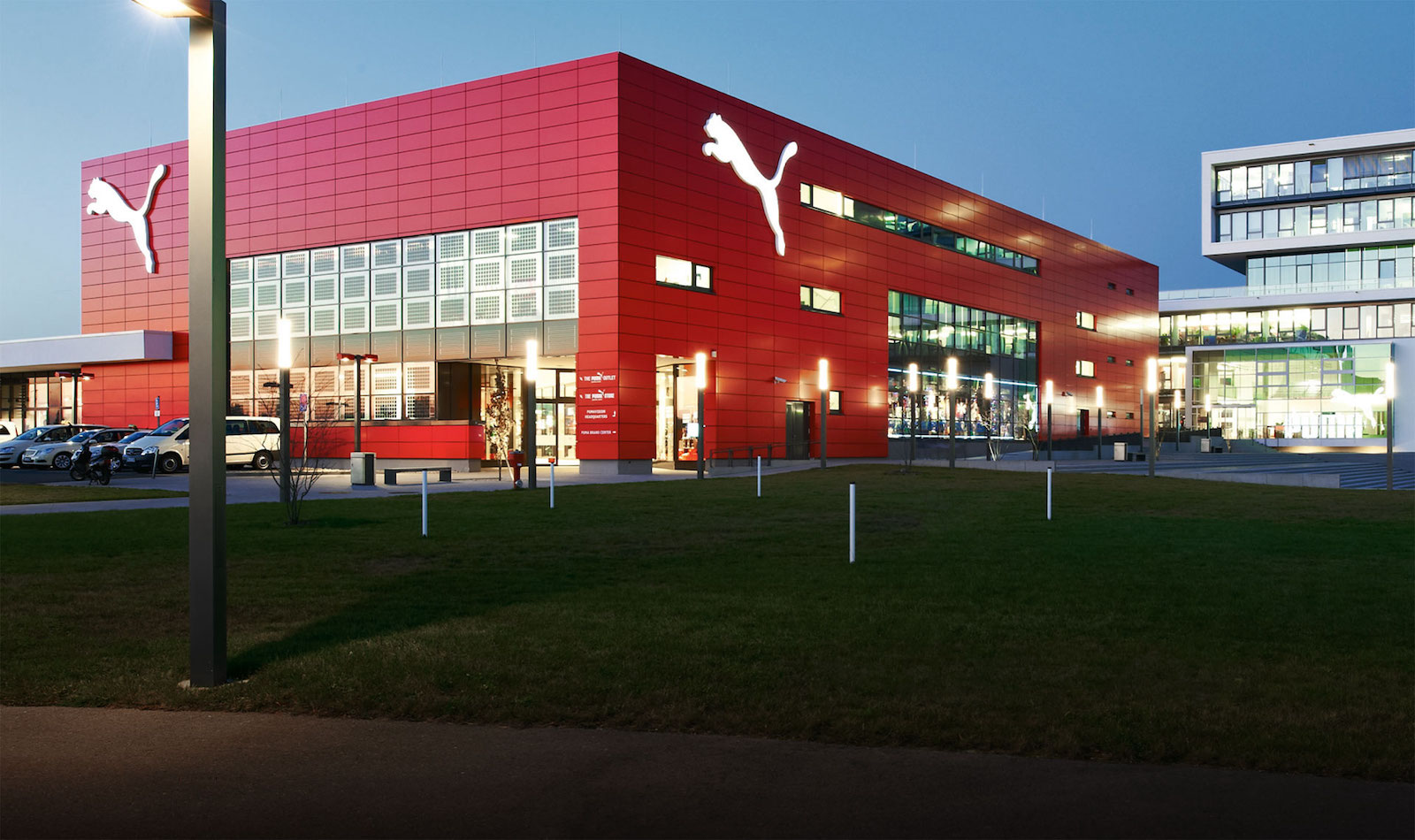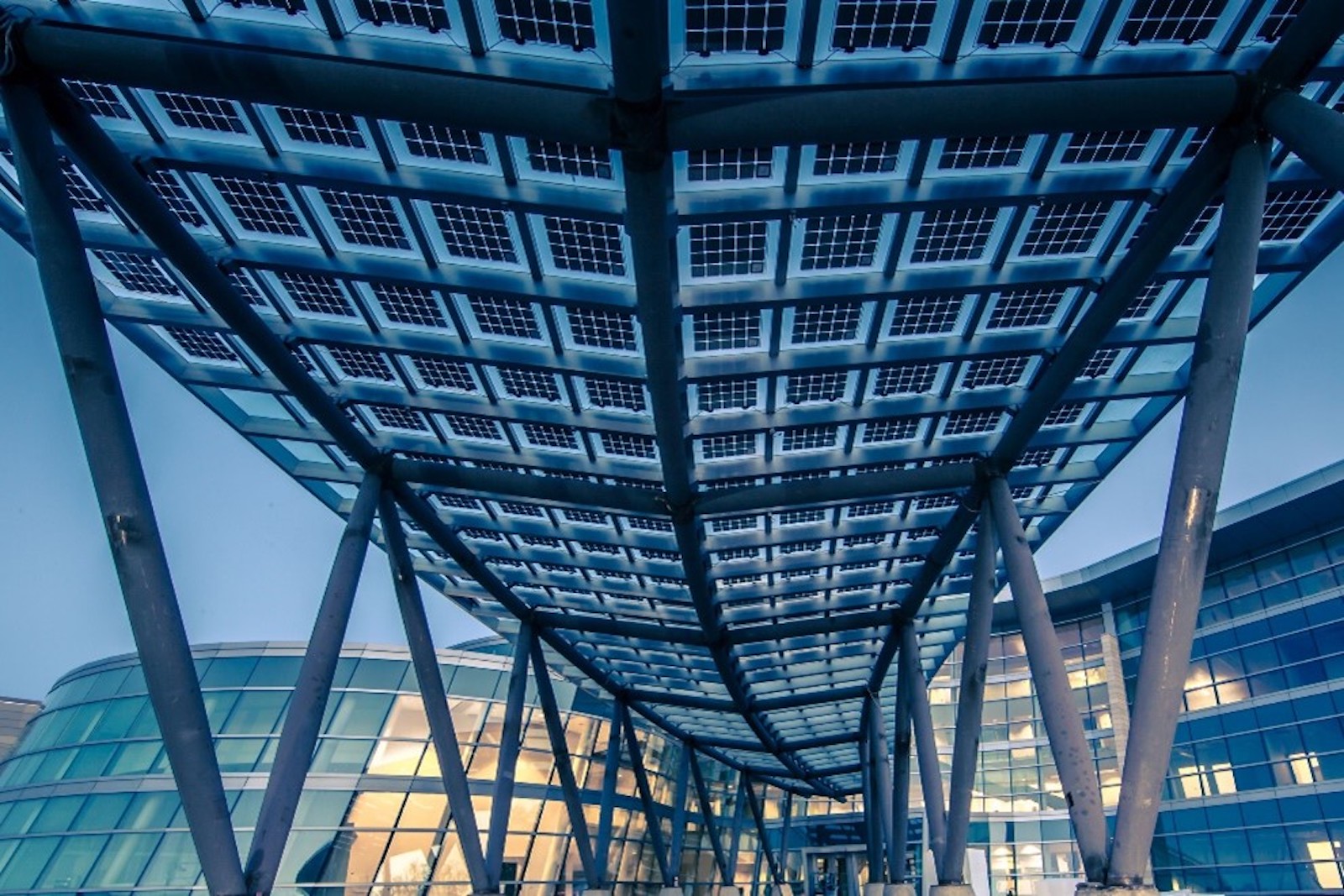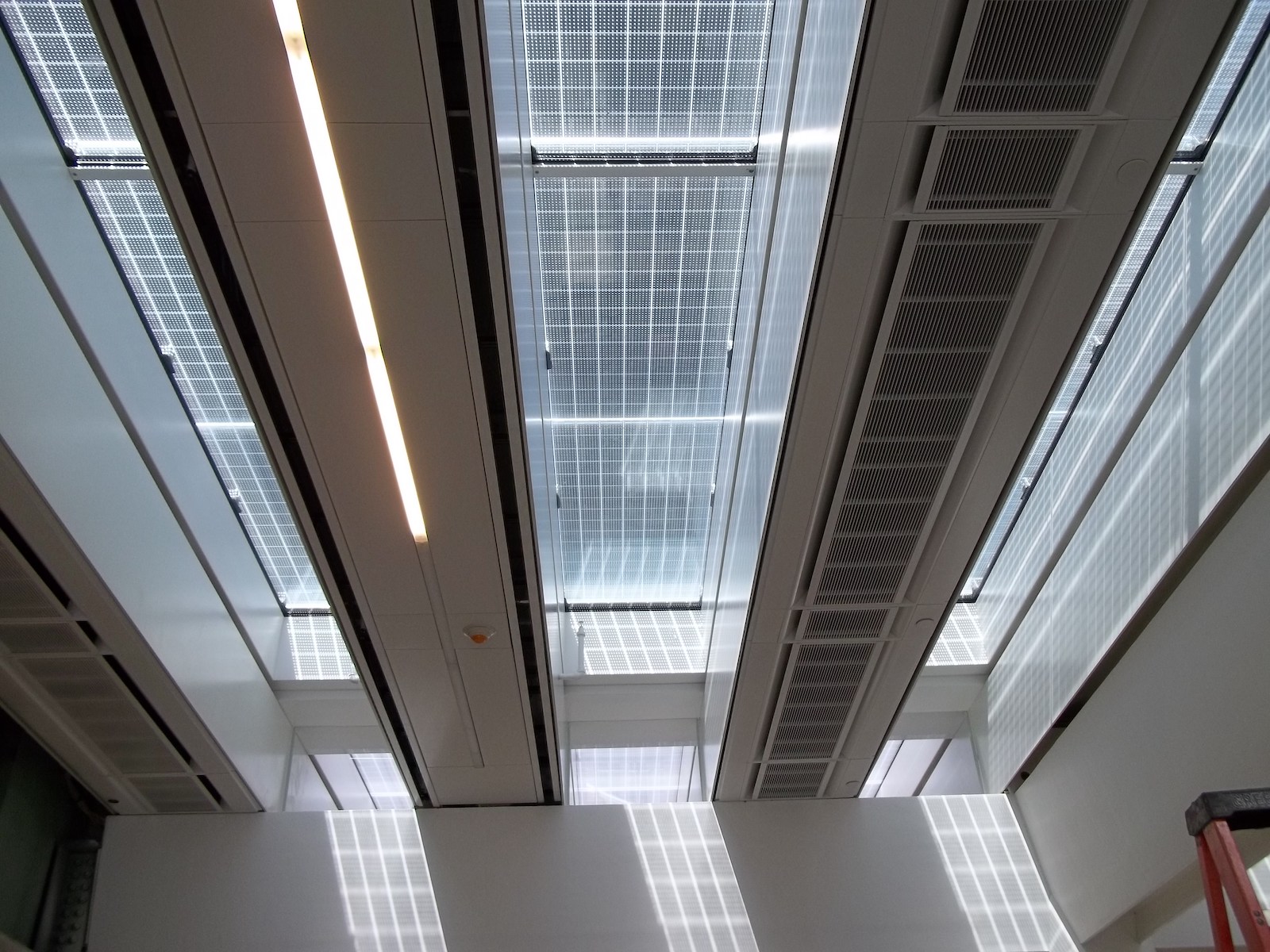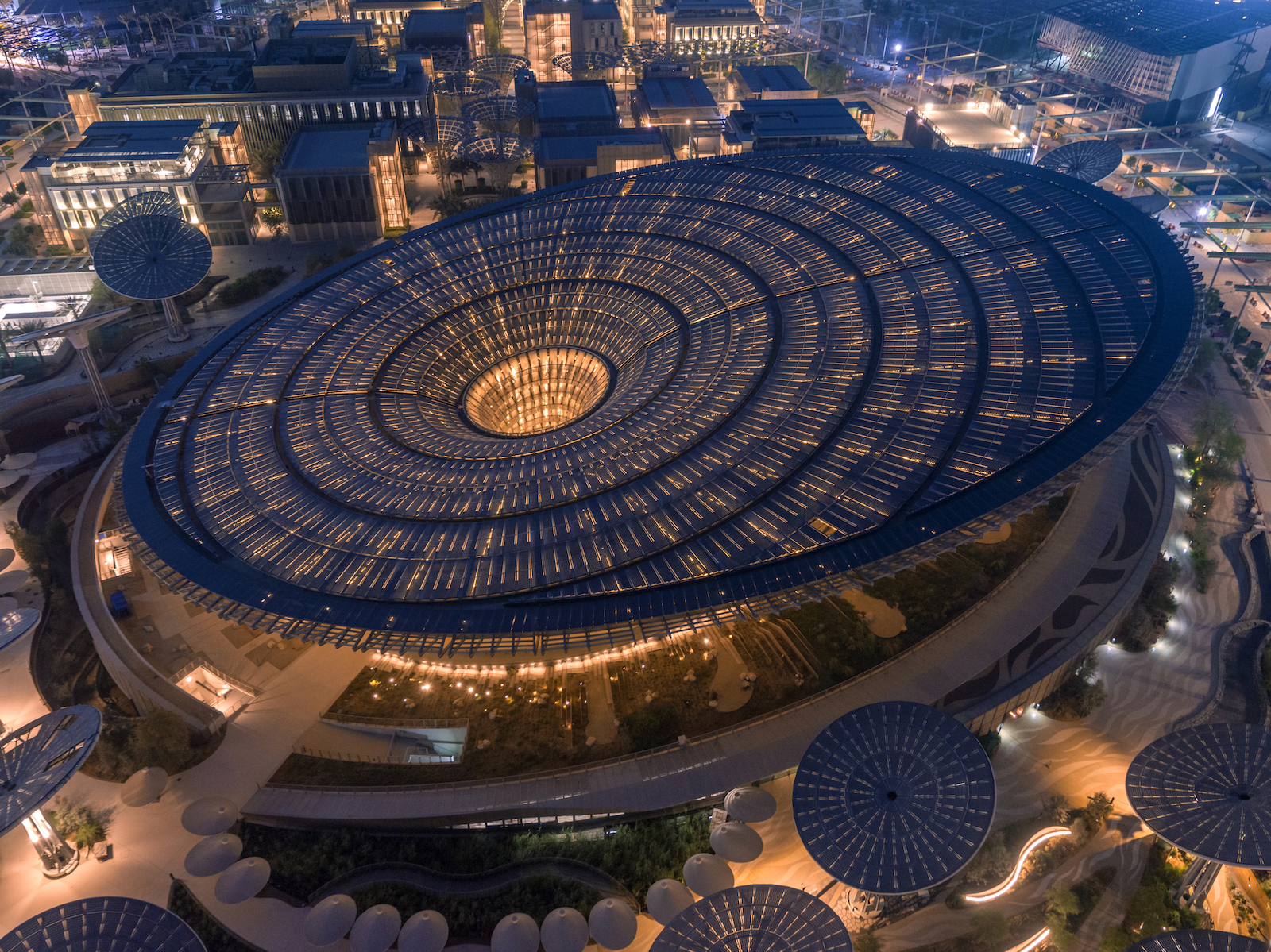Increasingly, building teams are comparing the use of building-integrated photovoltaic (BIPV) systems for façades, roofs, and other architectural assemblies with a promising and much easier alternative: conventional solar panel arrays, either on their building or off-site, to supplement their resiliency and decarbonization efforts. Recent examples include a tech company headquarters in Silicon Valley and a university in Arizona. In both cases, the project teams chose to expand their solar farms in nearby locations rather than use integrated PV technologies.
A growing group, however, is working harder. They are making BIPV an integral part of their latest green building works, contributing to a market expanding at about 15 percent per year. From the cascading glass skylights at the Edmonton Convention Center and the PV roof array overhanging the Bullitt Center in Seattle, to the new curved pavilion created for Dubai Expo and the modern PV façade at the University of Washington, creative applications generating ample electric loads are found worldwide, according to maker Onyx Solar.
“BIPV applications are challenging, and location and context are key to their early evaluations,” says John Ivanoff, an Associate Principal with Buro Happold’s façades and specialty structures team. “Arizona has more sunny days than Alaska or Maine. In some cities, there are recent code changes, such as in New York, where if the roof exceeds a certain area, the project team is required to evaluate the use of PV on the building.”
In urban contexts, neighboring buildings may cast excessive shadows, so the site itself is another aspect of the analysis, adds Ivanoff, who has worked on various innovative BIPV projects including Terra – The Sustainability Pavilion, which opened to the public in 2021 as one of the top three attractions of the Expo 2020 Dubai, UAE.
“BIPV is a challenge because the solar panels work best when on a slight angle, and vertical glass applications don’t always harness the sun in a direct enough way,” says Mark Rhoads, AIA, LEED AP, Associate Principal with Grimshaw, the architecture firm that designed Terra. “So the biggest challenges arise in applying BIPV to non-roof conditions.”
When Grimshaw and Buro Happold collaborated on Dubai’s Sustainability Pavilion, the recently completed educational venue for the client, Expo 2020 Dubai, the stakes were high. Promoting ecology, sustainable technologies, and green design, the project’s core building offers 86,000 sf of exhibition space that includes an auditorium, courtyard, and reservoir. “Soaring over the courtyard, the pavilion’s canopy accommodates more than 64,600 sf (6,000 sm) of ultra-efficient monocrystalline photovoltaic cells embedded in glass panels,” according to Grimshaw’s design team. “The combination of the cell and the glass casing allow the building to harness solar energy while providing shade and daylighting to the visitors below.”
Drawing inspiration from complex natural processes like photosynthesis, the deployable freestanding shade structures are constructed from steel and complex composites, structurally optimized to support an 18-meter photovoltaic array to harvest solar energy. Like a sunflower, the array rotates 180 degrees to follow the sun throughout the course of the day, maximizing energy yield and boosting solar cell efficiency. The bespoke trapezoidal panels employ highly efficient monocrystalline PV cells, embedded within three layers of glass, providing shade below without casting severe shadows or blocking views to the sky.
THE LATEST IN BIPV TECHNOLOGY


Monocrystalline solar cells represent one of four basic BIPV technologies, according to Vitro Solarvolt, a BIPV maker: “It renders a black appearance on solar cells with maximum energy-generation performance, while polycrystalline PV delivers a striking blue appearance with slightly reduced performance,” and it can be less expensive, as well. To provide a patterned appearance and higher visible light transmission (VLT) while retaining some of the energy generation benefits of monocrystalline PV, striped monocrystalline PV offers another option.
Buro Happold’s Ivanoff adds that thin film PV may be suitable for some applications. Thin films require less material, are generally cheaper but result in lower in efficiencies—110-130 peak watts per square meter (Wp/m2) versus 200 Wp/m2 for monocrystalline and 160 Wp/m2 for polycrystalline. Two thin film technologies can be integrated with glass—amorphous silicon (A-Si) and copper indium gallium selenide (CIGS)—and a third, cadmium telluride (CdTe), works for opaque panels. Vitro notes that BIPV glass panels can be used with spandrel glass, as well as low-emissivity (low-e) coatings and glass substrates, including tinted glass. Printed glass shingles are also well-established on the market, says Ivanofff, with surfaces that may be printed to look like other materials such as with a faux brick finish. Customized colored glass, he adds, is increasingly attractive to building teams.
Both Rhoads and Ivanoff stress that glass safety and fire performance should be considered, especially in horizontal and angled applications: “These are electronic elements, and in the UK, the Netherlands, and some U.S. jurisdictions it is regulated for fire safety,” says Rhoads. “Overheating is another issue in operations.” In addition to glass panels, other ways to integrate BIPV include vertically mounted high-performance panels, PV-covered louvers or shades—if those offer sufficient surface area—and street furniture integrated with PV panels, such as the bus shelters and sidewalk shade structures in Los Angeles, Singapore, and some Texas cities, says Ivanoff.

In many cases, however, skylights are seen as the ideal BIPV armature. The pharmaceutical giant Novartis opened its headquarters building a few years ago with the largest BIPV skylight in the world. “The photovoltaic skylight covers 27,500 square feet and consists of hundreds of large transparent photovoltaic glass units developed by Onyx Solar,” according to Power Engineering International, which worked with architect Rafael Viñoly Architects to complete the project. These horizontal and low-slope applications, including roof windows and solar cell covers for simple pedestrian shelters, perform optimally only when maintained well, says Grimshaw’s Rhoads: “Cleanliness is an important consideration. If your cells get covered in dust, the panels lose efficiency exponentially. So maintenance is key to keep them clean,” he explains, noting that the Dubai Expo panels are cleaned almost daily. Ivanoff adds that robotic cleaning systems used in desert solar arrays and on some new towers—along with dedicated maintenance crews—are important players in the drive to optimize efficiencies and yield of PV cells on BIPV systems over the life of the buildings.
In spite of the obstacles, Rhoads expects BIPV applications to expand as the technology becomes more ubiquitous and easy to specify. “These systems create a nice transparent condition,” he says, “and they are as integrated as possible since they power their buildings, bringing us closer to net-zero operations.”
Related Stories
Industrial Facilities | Apr 9, 2024
Confessions of a cold storage architect
Designing energy-efficient cold storage facilities that keep food safe and look beautiful takes special knowledge.
AEC Innovators | Feb 28, 2024
How Suffolk Construction identifies ConTech and PropTech startups for investment, adoption
Contractor giant Suffolk Construction has invested in 27 ConTech and PropTech companies since 2019 through its Suffolk Technologies venture capital firm. Parker Mundt, Suffolk Technologies’ Vice President–Platforms, recently spoke with Building Design+Construction about his company’s investment strategy.
MFPRO+ Special Reports | Feb 22, 2024
Crystal Lagoons: A deep dive into real estate's most extreme guest amenity
These year-round, manmade, crystal clear blue lagoons offer a groundbreaking technology with immense potential to redefine the concept of water amenities. However, navigating regulatory challenges and ensuring long-term sustainability are crucial to success with Crystal Lagoons.
AEC Tech | Feb 20, 2024
AI for construction: What kind of tool can artificial intelligence become for AEC teams?
Avoiding the hype and gathering good data are half the battle toward making artificial intelligence tools useful for performing design, operational, and jobsite tasks.
Building Tech | Feb 20, 2024
Construction method featuring LEGO-like bricks wins global innovation award
A new construction method featuring LEGO-like bricks made from a renewable composite material took first place for building innovations at the 2024 JEC Composites Innovation Awards in Paris, France.
Modular Building | Jan 19, 2024
Building with shipping containers not as eco-friendly as it seems
With millions of shipping containers lying empty at ports around the world, it may seem like repurposing them to construct buildings would be a clear environmental winner. The reality of building with shipping containers is complicated, though, and in many cases isn’t a net-positive for the environment, critics charge, according to a report by NPR's Chloe Veltman.
Sponsored | BD+C University Course | Jan 17, 2024
Waterproofing deep foundations for new construction
This continuing education course, by Walter P Moore's Amos Chan, P.E., BECxP, CxA+BE, covers design considerations for below-grade waterproofing for new construction, the types of below-grade systems available, and specific concerns associated with waterproofing deep foundations.
Mass Timber | Jan 2, 2024
5 ways mass timber will reshape the design of life sciences facilities
Here are five reasons why it has become increasingly evident that mass timber is ready to shape the future of laboratory spaces.
Sustainability | Nov 1, 2023
Researchers create building air leakage detection system using a camera in real time
Researchers at the U.S. Department of Energy’s Oak Ridge National Laboratory have developed a system that uses a camera to detect air leakage from buildings in real time.
Engineers | Oct 12, 2023
Building science: Considering steel sheet piles for semi-permanent or permanent subsurface water control for below-grade building spaces
For projects that do not include moisture-sensitive below-grade spaces, project teams sometimes rely on sheet piles alone for reduction of subsurface water. Experts from Simpson Gumpertz & Heger explore this sheet pile “water management wall” approach.
















